

Multotec's on-site test unit in Madagascar finds solutions


The test results for using the Multotec cyclone test unit showed reduced levels of coarse chrome in the slurry and more valuable minerals were recovered
When a Madagascar mine wanted to reduce the high wear in the pipelines to its process plant, it called on Multotec to conduct cyclone tests and provide recommendations.
Coarse chrome particles in the feed from the nickel laterite deposit were highly abrasive, and were also causing blockages in pipelines, pump boxes, holding tanks and sumps at the operation. According to Faan Bornman, technology manager : research and development at Multotec’s technology division, the aim was to remove the coarse particles via the cyclone underflow, while recovering as much of the valuable cobalt and nickel in the overflow. The coarse material was specified as being between 150 microns and 1 mm in size.
Multotec constructed and shipped a cyclone test rig to the site towards the end of 2021, where it was put to work for two weeks conducting sampling at two strategic points.
“We were able to identify the cyclone configuration that delivered the best efficiency performance at each sampling point,” says Bornman. At both points, the cyclone spigot was optimised at 20 mm for all the tests.
The test work generated a total of 17 tests, resulting in 153 samples which were each dried, weighed, screened for particle size distribution, and analysed by the inductively coupled plasma (ICP) method to measure the elements.
“Our optimal cyclone configuration at the customer’s first sampling point was able to reduce the coarse chrome content of around 10% in the feed to just over 1% in the overflow,” he explains. This result was achieved using a VV250 flat-bottomed cyclone with four barrels, an A inlet head and an A-type vortex finder; the pressure and feed slurry density were also important variables.
Similar success was achieved by the second sampling point, with a similar configuration but with one barrel. Here, the coarse fraction was reduced from almost 15% in the feed to just 1,2% in the overflow – a reduction of over 90%.
“Multotec’s extensive field experience, combined with our metallurgical expertise and wide portfolio of process equipment, gives customers optimal value from our test work capabilities – either on-site or in our extensive facilities in South Africa,” he says.



